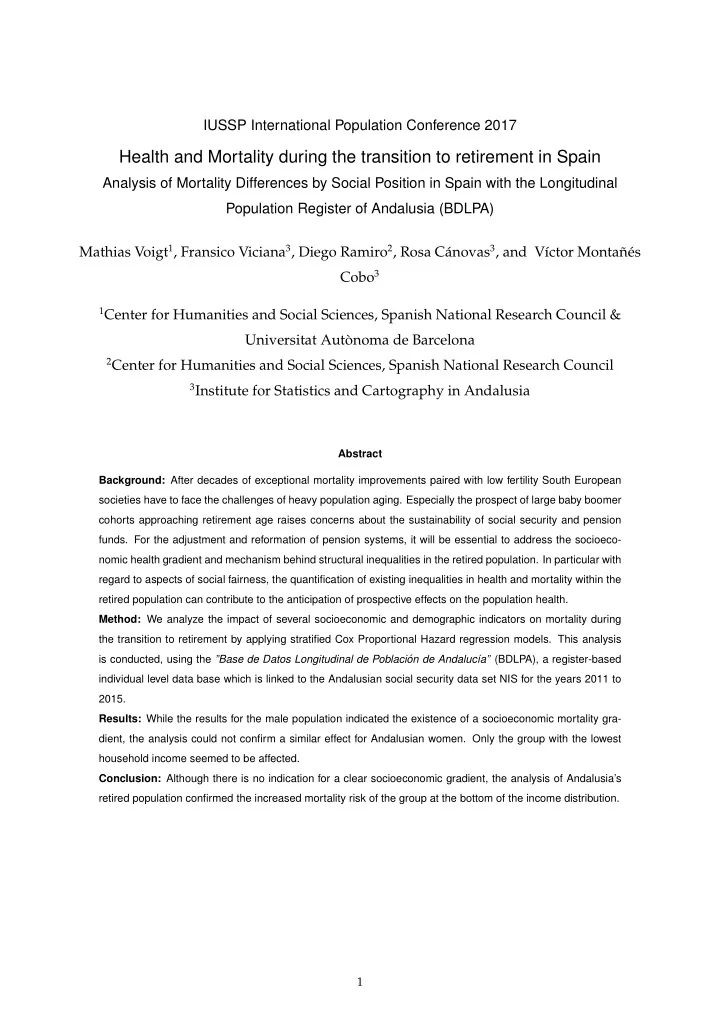

IUSSP International Population Conference 2017 Health and Mortality during the transition to retirement in Spain Analysis of Mortality Differences by Social Position in Spain with the Longitudinal Population Register of Andalusia (BDLPA) Mathias Voigt 1 , Fransico Viciana 3 , Diego Ramiro 2 , Rosa C´ anovas 3 , and V´ ıctor Monta˜ n´ es Cobo 3 1 Center for Humanities and Social Sciences, Spanish National Research Council & Universitat Aut` onoma de Barcelona 2 Center for Humanities and Social Sciences, Spanish National Research Council 3 Institute for Statistics and Cartography in Andalusia Abstract Background: After decades of exceptional mortality improvements paired with low fertility South European societies have to face the challenges of heavy population aging. Especially the prospect of large baby boomer cohorts approaching retirement age raises concerns about the sustainability of social security and pension funds. For the adjustment and reformation of pension systems, it will be essential to address the socioeco- nomic health gradient and mechanism behind structural inequalities in the retired population. In particular with regard to aspects of social fairness, the quantification of existing inequalities in health and mortality within the retired population can contribute to the anticipation of prospective effects on the population health. Method: We analyze the impact of several socioeconomic and demographic indicators on mortality during the transition to retirement by applying stratified Cox Proportional Hazard regression models. This analysis is conducted, using the ”Base de Datos Longitudinal de Poblaci´ on de Andaluc´ ıa” (BDLPA), a register-based individual level data base which is linked to the Andalusian social security data set NIS for the years 2011 to 2015. Results: While the results for the male population indicated the existence of a socioeconomic mortality gra- dient, the analysis could not confirm a similar effect for Andalusian women. Only the group with the lowest household income seemed to be affected. Conclusion: Although there is no indication for a clear socioeconomic gradient, the analysis of Andalusia’s retired population confirmed the increased mortality risk of the group at the bottom of the income distribution. 1
Introduction South Europe experiences a rapid change of their population structure. Decades of low birth rates in com- bination with a historically unique improvement in mortality rates across all ages have led to shrinking and heavily aging populations [1, 2]. Despite the remarkable opportunity for millions of people to enjoy longer lives in a better health compared to previous generations [3, 4], the growth of average human life lengths entails considerable challenges for social security systems [5]. A growing number of welfare or pension recipients is increasing the pressure on the working age population which itself is declining at the same time. The Old-Age Dependency Ratio 1 in Spain and Italy is projected to increase from 0.33 to about 0.5 until 2050 and therewith exceeds values of most North and Central European countries [6, 7]. Besides the pressure caused by demographic aging, South European economies were hit extraordinarily hard by the global financial crisis in 2008. Austerity policies in answer to the recession additionally jeopardized the sustainability of social service budget and public pension funds [8, 9]. Consequently, policy makers were forced to react and initiated modifications with regard to the access to public pensions following the example of other European countries. In Italy and Spain adjustable conversion factors were implemented in the pension formula which determine future pension sizes and eligibility ages based on life expectancy [10, 11]. The extension of the working life in particular promises to be a relative efficient and cost-effective adjustment to the population development and would postpone shortages of pension funds to the future [12, 13]. Regarding social fairness, however, it is important to ask if the additional burden which is imposed on the population by prolonging their working lives and cutting their pensions is shared equally. In other words, will such reforms affect particular social groups more negatively than other and increase existing health inequities? Since the average life expectancy was chosen to determine the eligibility to full pension, heterogeneity with re- gard to survival remains unconsidered. Thus, if structural inequalities with regard to health and survival exist within the society and are related to forms of occupation or other socioeconomic characteristics, raising the eligibility age could manifest and reinforce advantages of social groups over others. In order to estimate the impact of changes in the eligibility age and pension size on the health and survival, it is necessary to acquire more detailed knowledge about the structural mechanisms which shape the health of the retiring population. Apart from the aspect of fairness, knowledge about structural health differentials by socio-economic and demographic characteristics are essential for the estimation of expenditures for future care need. We aim to fill a part of this void with our analysis of structural mortality differences during and after the transition to retirement. After describing the underlying mechanisms for our examination, we introduce a relatively underused longitudinal data structure provided by our project partner, the Institute for Cartography and Statistics of Andalusia (ICEA). The register-based data infrastructure allowed us to obtain follow-up data for mortality after entry into the public pension system in combination with the Spanish Population and House- hold census of 2001. We apply stratified Cox proportional hazard models to separately estimate the mortality differentials for women, men and married couples depending on various socioeconomic measures over time. N 65+ 1 D = N 15 − 64 ; where N 65+ is the population 65 years and older, and N 15 − 64 the population in working ages 2
Recommend
More recommend